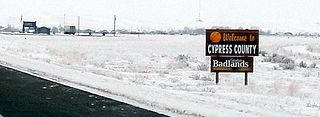
Cypress Hill is an American hip hop group from South Gate, California, formed in 1988. They have sold over 20 million albums worldwide, and they have obtained multi-platinum and platinum certifications. The group has been critically acclaimed for their first five albums. They are considered to be among the main progenitors of West Coast hip hop and 1990s hip hop. All of the group members advocate for medical and recreational use of cannabis in the United States. In 2019, Cypress Hill became the first hip hop group to have a star on the Hollywood Walk of Fame.

The Cypress Hills are a geographical region of hills in southwestern Saskatchewan and southeastern Alberta, Canada. The hills are part of the Missouri Coteau upland. The hills cover an area of approximately 2,500 km2 (970 sq mi). About 400 km2 (150 sq mi) or 16% of this area is an interprovincial park.

The Cypress Hills Massacre occurred on June 1, 1873, near Battle Creek in the Cypress Hills region of Canada's North-West Territories. It involved a group of American bison hunters, American wolf hunters or "wolfers", American and Canadian whisky traders, Métis cargo haulers or "freighters", and a camp of Assiniboine people. Thirteen or more Assiniboine warriors and one wolfer died in the conflict. The Cypress Hills Massacre prompted the Canadian government to accelerate the recruitment and deployment of the newly formed North-West Mounted Police.
Irvine is a hamlet in Alberta, Canada within Cypress County. It is located approximately 35 kilometres (22 mi) east of Medicine Hat on Highway 1 and has an elevation of 763 metres (2,503 ft). The hamlet is located in census division No. 1 and in the federal riding of Medicine Hat.

Entelodontidae is an extinct family of pig-like artiodactyls which inhabited the Northern Hemisphere from the late Eocene to the early Miocene epochs, about 38-19 million years ago. Their large heads, low snouts, narrow gait, and proposed omnivorous diet inspires comparisons to suids and tayassuids (peccaries), and historically they have been considered closely related to these families purely on a morphological basis. However, studies which combine morphological and molecular (genetic) data on artiodactyls instead suggest that entelodonts are cetancodontamorphs, more closely related to hippos and cetaceans through their resemblance to Pakicetus, than to basal pigs like Kubanochoerus and other ungulates.

Cypress Hills Interprovincial Park is a natural park in Canada straddling the Alberta / Saskatchewan boundary and jointly administered by the two provinces. Located south-east of Medicine Hat in the Cypress Hills, it became Canada's first interprovincial park in 1989.

Dunmore is a hamlet in Alberta, Canada, within Cypress County, 2.6 kilometres (1.6 mi) southeast of Medicine Hat's city limits on Highway 1 and the Canadian Pacific Railway mainline. A portion of the hamlet is recognized as a designated place by Statistics Canada.

Maple Creek is a town in the Cypress Hills of southwest Saskatchewan, Canada. It is surrounded by the Rural Municipality of Maple Creek No. 111. The population was 2,176 at the 2021 Census.

Archaeotherium is an extinct genus of entelodont artiodactyl endemic to North America during the Eocene and Oligocene epochs. Archaeotherium fossils are most common in the White River Formation of the Great Plains, but it has also been found in the John Day Basin of Oregon and the Trans-Pecos area of Texas.

Daeodon is an extinct genus of entelodont even-toed ungulates that inhabited North America about 29 to 15.97 million years ago during the latest Oligocene and earliest Miocene. The type species is Daeodon shoshonensis, described by a very questionable holotype by Cope. Some authors synonymize it with Dinohyus hollandi and several other species, but due to the lack of diagnostic material, this is questionable at best.

Cypress County is a municipal district in southeastern Alberta, Canada that surrounds the City of Medicine Hat and the Town of Redcliff. The municipality is part of Census Division 1, Alberta. The first farm in the area was settled in 1890.
A pig is a mammal of the genus Sus.
The Chadronian is a North American Land Mammal Age typically set from around 37,000,000 to 33,700,000 years BP, a period of 3.3 million years. The Chadronian is preceded by the Duchesnean and followed by the Orellan NALMA stages. Relative to global geological chronology, it is usually considered to fall within the later part of the Eocene epoch, ending around the same time as the Eocene-Oligocene boundary.
Brachyhyops is an extinct genus of entelodont artiodactyl mammal that lived during the Eocene Epoch of western North America and southeastern Asia. The first fossil remains of Brachyhyops are recorded from the late Eocene deposits of Beaver Divide in central Wyoming and discovered by paleontology crews from the Carnegie Museum of Natural History during the early 20th century. The type species, Brachyhyops wyomingensis, is based on a single skull and was named by E.H. Colbert in 1937, but was not officially described until 1938. During the latter half of the 20th century, additional specimens from North America have been recorded from Saskatchewan and as far south as Texas, indicating that Brachyhyops had a broad distribution and was well-dispersed throughout western North America.

Paraentelodon is an extinct entelodont from the Late Oligocene and Oligocene-Miocene boundary of Asia. The fossils of the type species P. intermedium were found in Georgia, Kazakhstan and China. An indeterminate species represents in Bugti Hills which is the late Oligocene of Pakistan.
The Ravenscrag Formation is a stratigraphic unit of early Paleocene age in the Western Canada Sedimentary Basin. It was named for the settlement of Ravenscrag, Saskatchewan, and was first described from outcrops at Ravenscrag Butte near the Frenchman River by N.B. Davis in 1918.
The Cypress Hills Formation is a stratigraphic unit of middle Eocene to early Miocene age in the Western Canada Sedimentary Basin. It is named for the Cypress Hills of southeastern Alberta and southwestern Saskatchewan and was first described from outcrops on the slopes of the Cypress Hills in 1930. It is known for preserving a wealth of vertebrate fossils.

Carry the Kettle Nakoda Nation is a Nakota (Assiniboine) First Nation in Canada located about 80 km (50 mi) east of Regina, Saskatchewan and 13 km (8.1 mi) south of Sintaluta. The reservation is in Treaty 4 territory.
Jeremy Patzer is a Canadian politician who was elected to represent the riding of Cypress Hills—Grasslands in the House of Commons of Canada in the 2019 Canadian federal election. He previously served on the board of the Conservative Party constituency association for the riding of Cypress Hills—Grasslands.

Helohyidae were a group of artiodactyl mammals. They were most prominent in the mid-to-upper Eocene.












